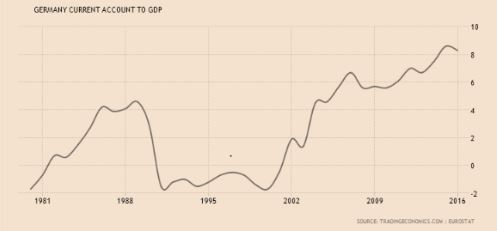The Complex Source Of Germany’s Huge Current Account Surplus
“In the case of Germany, as in any surplus country, savings may be too high, but investment also may be too low. And while both factors reflect the behavior of individual households, firms, or the government, large surpluses, more often than not, are a result of high saving rates among households in aging societies. That would certainly describe Germany.” (Fabrizio Coricelli, Surmounting the German Surplus, Project Syndicate, Sept.8, 2017)
Germany’s current account surplus reached an all time high of 8.6% of GDP in 2015. Last year the surplus was still very high at 8.3% of GDP.
The argument is often made that Germany has been unfairly pursuing a mercantilist approach to world trade at the expense of its trading partners. Others point out that Germany’s large current account (CA) surplus is simply a reflection of the fact that the country saves too much, and invests too little.
Germany’s large CA surplus is also a reflection of the deficits recorded in other countries.
As Fabrizio points out, the U.S., which has recently been experiencing a modest decline in its current account deficit, still accounts for about one third of the total world current account deficits.
Moreover, Reinhart and Daniel Gros of the Center for European Policy Studies in Brussels point out that Germany is hardly the only country to run large surpluses.
According to Gros, “All northern European countries with a Germanic language are running a current-account surplus, including the Netherlands, Switzerland, Sweden, and Norway, each of whose surpluses, relative to GDP, exceeded that of Germany at the time. Gros argues that critics who do not also accuse these countries of ‘mercantilist policies’ and competitive wage restraint are applying a double standard.
On the other hand, Germany’s surplus has indeed been persistent, dating as far back to 2002. And the CA deficits that it ran in the 1990s largely reflected the enormous fiscal expansion that accompanied the reunification of East and West Germany – a one-time event. However, the CA surpluses of other advanced economies do not necessarily invalidate the claim that Germany’s own current account reflects mercantilist policies. Very different factors could be contributing to the current account balances among northern European countries, to say nothing of those in Asia and elsewhere.
In Germany’s case, the trade balance started to improve more than a decade ago, when German employers and unions agreed to restrain wage growth. While workers weren’t thrilled, nonetheless the common view was that the Germany economy was not sufficiently competitive. This amounted to a devaluation of Germany’s production costs within the Euro Zone.
Currently the best way out of today’s imbalance problem within the Euro Zone is not to keep cutting wages in the depressed countries like Greece and Portugal, but to encourage wages to rise faster in Germany. Wages have been rising in Germany—by 2.3% last year—but should increase faster.
The other factor to consider is that Germany, as an ageing society, may have been saving much more than is really needed.
Germany’s Current Account Balance As A % Of GDP

Disclosure: None.



